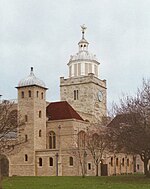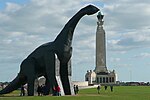Clarence Pier
Amusement parks in EnglandBuildings and structures in HampshireBurned buildings and structures in the United KingdomPier firesPiers in Hampshire ... and 2 more
Tourist attractions in HampshireUse British English from May 2017

Clarence Pier is an amusement pier in Portsmouth, Hampshire. It is located next to Southsea Hoverport. Unlike most seaside piers in the UK, the pier does not extend very far out to sea and instead goes along the coast.
Excerpt from the Wikipedia article Clarence Pier (License: CC BY-SA 3.0, Authors, Images).Clarence Pier
Long Curtain Road, Portsmouth Old Portsmouth
Geographical coordinates (GPS) Address Nearby Places Show on map
Geographical coordinates (GPS)
| Latitude | Longitude |
|---|---|
| N 50.786066666667 ° | E -1.1011333333333 ° |
Address
Treasure Island Adventure Golf
Long Curtain Road
PO5 3AX Portsmouth, Old Portsmouth
England, United Kingdom
Open on Google Maps










